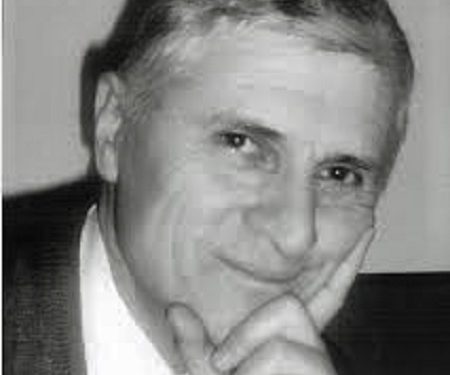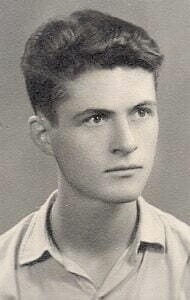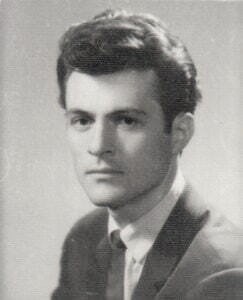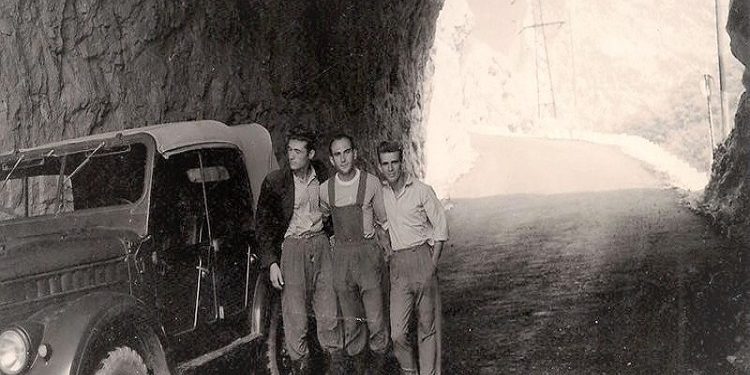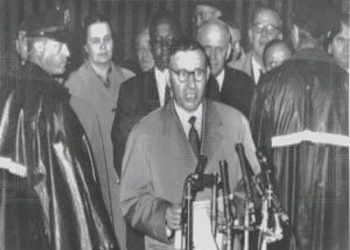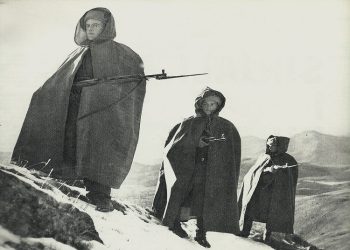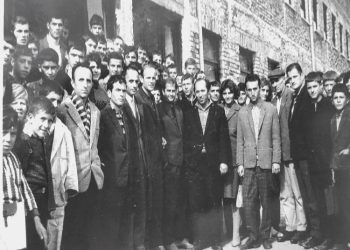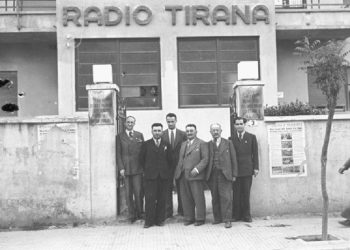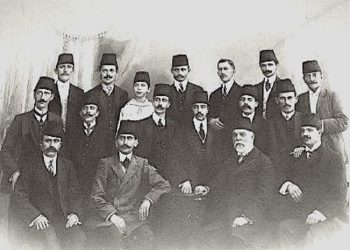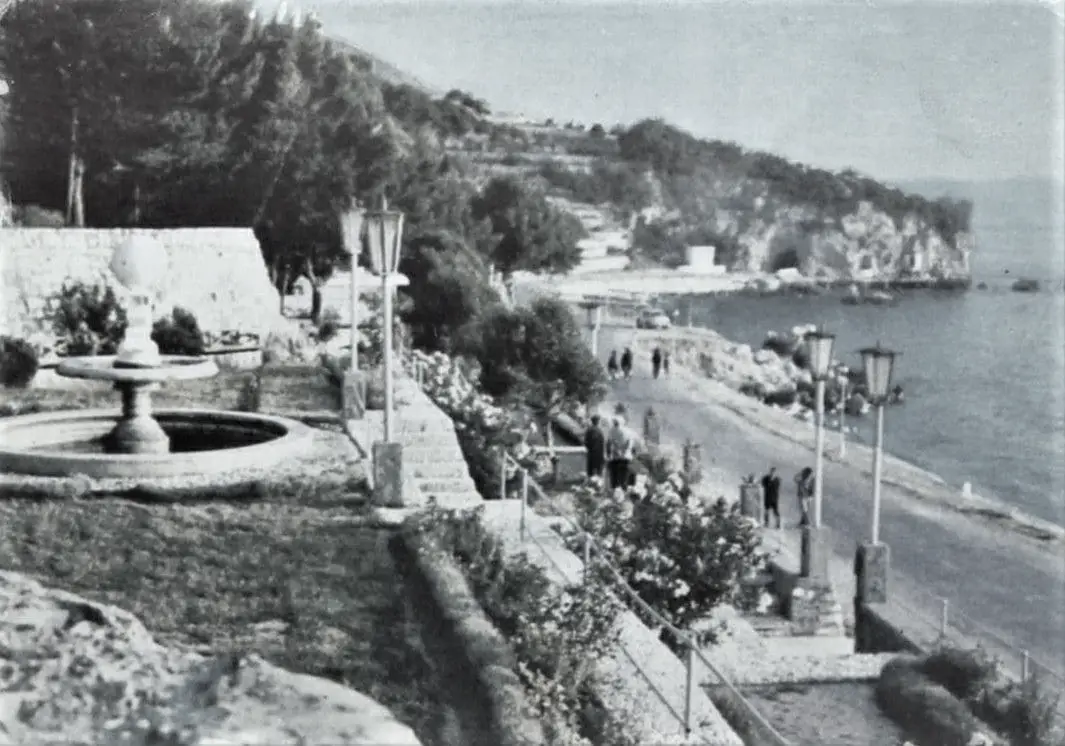By Izet S. Çuli
Memorie.al / Latif Qazimi (Fodulli) completed four primary classes with excellent results in the village of Çepan in the district of Skrapar, while he also finished the unique school in the “Uji i Ftohte” Dormitory, Vlorë, in the years 1951-1954. Then they sent him to Tirana to the “7 November” Polytechnic, the four years of which he finished with excellent results, not only in lessons but also in other areas of school life: literature, drawing, sports, activist of the organization resume etc. Thirsty for knowledge, talented and with an admirable will, Latif excelled in the Albanian language, mastered the Russian language, wrote plays and skits, played in the artistic group, published for four years, together with Llambi Blido, the school’s honorary newspaper. After graduating as a technical-geologist, he was assigned to work in the Department of the Ministry of Construction, but in reality he worked in eight energy, industrial and agricultural projects in Albania.
Although time passed through the foundations of his works, he did not give up on literature and art. Thuri published poetry and journalistic articles, wrote stories and sketches, kept a regular diary. Like all young people of the time, his dream was to continue higher studies, abroad or within the country. Latifi applies to the Institute of Arts and wins in July 1961, but is sent to China to study in October 1961.
Even there, five years with excellent results, in lessons, in student life, in studies, literature, drawings, translations, etc. He earned the degree of electro-metallurgical engineer and after returning to his homeland, he was appointed to work at the newly created Poliçan Military Plant, although he was supposed to be appointed at the Metallurgical Combine of Elbasan, which was in its infancy. Already Latifi had created a complete engineering and literary profile, moreover, in addition to the Russian language, he mastered the Chinese and English languages and had good knowledge of the Greek, German, French and Esperanto languages.
Enigmatic sudden death…!
…and on May 12, 1967, Latif S. Qazimi, as the official state version was given only verbally, by chance, by a passing driver, was found dead in a shallow of the Vjosa river, near the Dragot Bridge in the district of Tepelena . Initially, it was considered: “he died as an enemy of the people” and then, “the family could come and take the body of the deceased in the hermetically sealed coffin”.
The act of burial was performed on May 14, 1967 in the forenoon in the country-east, in Çepan. It was said by the people in the field of investigation, that investigative files were opened, expertise was done, material evidence was taken and the official answer remained the same one dated May 12, 1967: he drowned himself! The enigma continues even after fifty-five years. Why was the family not allowed to see the documentation of this death…?! Did they kill him or did they commit suicide…!? Why was it completely forgotten by both economic and social systems?
The rich legacy of Latif Qazim: engineer, poet, writer, critic, translator, artist…!
Despite his very short life, only 27 years old, he left a considerable legacy in terms of the profession he practiced as a geological technician and as an electro-metallurgical engineer, although he did not manage to start implementing the latter as he wished. . The biggest thing he left us is his love for Albania, his work in general and for the craft of geologist and metallurgist in particular, as well as his great passion for literature and art.
First, we must mention the Bistrica and Shkopet hydropower plants, which were objects of special national importance, where Latifi invested sweat and knowledge, professional wisdom and organizational skills; in the studies for the construction of the foundations of these very large and completely new works for the time and the economic and intellectual opportunities of Albania.
Latif revealed all his physical and mental energies and fully deserved the attributes of a real engineer. He worked and lived on the construction site with the workers where he always showed his portrait as a man loved by his friends, with an art of spiritual communication that stood out everywhere and at any time.
Secondly, he led the work teams for the dam in the Kurjani and Thana reservoirs; for the installation of high voltage lines in Milot; the danger posed by massive landslides and how they would be prevented or dealt with in a facility in Përrenjas; the condition of the soil layers where the legs of an important bridge would be built in the Maliqi field in Korça; problems of underground water on the coast of Durrës beach and many other important objects.
Other treatments of a genuine study-scientific character have been, as far as we have found so far in the Central Technical Archive of Construction, in two not less important national objects such as the Caustic Soda Factory in Vlora and the expansion of the Porcelain Factory in Tirana. Although he worked for a very short time, only 149 days, he also left his mark in the foundry of the Poliçan Mechanical Plant and in the laboratory related to the analysis of metals for the production of infantry weapons.
From his literary and artistic heritage we mention:
He wrote much more diaries, but we could only find 404 pages in the manuscript; 74 poems prepared for publication; four of them were published in the newspaper “Voice of Youth” on September 30, 1960; other manuscripts, various, numbered, total approximately 187 pages; 16 stories and 44 sketches; landscapes and descriptions of nature and life in Roskovec, Plazh – Durrës, Bistrica, Anshan, are some of them.
In Latif’s manuscripts we find criticism of the performing arts, of the literature in prose and poetry of the time he lived, of painting and sculpture. 32 pages are critical only for Ismail Kadare’s poetry and work up to that time. Also in Latif’s manuscripts, there are translations from Russian and Chinese languages, fables, anecdotes, etc.
There are research outlines of the linguistic and folklore particles of the popular root of the Albanian language; proverbs translated and adapted by him comparatively in three languages: Albanian, Russian and Chinese. Latif’s 189 diverse drawings have received maximum appreciation from painters Skënder Kamberi, Anastas Kostandini, etc., and especially from the “People’s Sculptor”, Mumtaz Dhrami.
Under the care of the lawyer Përparim Kalo, with a selected part of these drawings, a much-appreciated exhibition was opened for three weeks at the “Kalo Gallery” in May 2016. He has written several parts of short theater performances and sketches, for which he has special interest and appreciation, “Teacher of the People”, Gjergji Canco, etc.
We have not been able to find a manuscript or typescript from them until now; in the magazine “For life and science” that was published by his school; he debuted several times with different articles. He had an extensive, very interesting correspondence with many people, friends, friends and well-wishers, of different professions and ages, Albanians, Chinese, Algerians, Russians, especially when he was a student in China, most of to which it is stored.
His manuscripts with prominent social and artistic values to be published constitute a series of small format books with a volume of approximately 1200 pages. His literary and artistic work has been whitewashed, edited and is awaiting the light of publication, based on the hope that someone with a big heart or even some cultural institution will be found to sponsor it. So far, the family has published two of his works.
The researcher, Ilmi S. Qazimi (and others), in addition to preparing Latif’s work for publication, has met about 300 people who knew Latif Qazimi, in his hometown, at school, in his life in Albania and China and in work and from them he heard or was given written impressions and evaluations from the highest about him.
He was unique, handsome, loving and compassionate. A man with subtle feelings and pure spiritual purity and with wide vital interests: participant in one of the moving performances of the National Song and Dance Ensemble of the People’s Republic of Albania, August 1959; actor in high school theater groups, active athlete in football, volleyball, rowing, chess player, singer, etc.
He was young looking away. An engineer with a clear vision for a bright future of his homeland and his people and who nurtured a deep love for Albania and especially for his homeland.
A man endowed with the magic of absorbing people’s souls and the art of communicating with everyone. Boy with obvious and appreciated artistic, poetic and acting tendencies. An idealistic intellectual, with a high conscience, who aspired for freedom, democracy and humanity everywhere in the recesses of human life. Memorie.al




